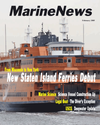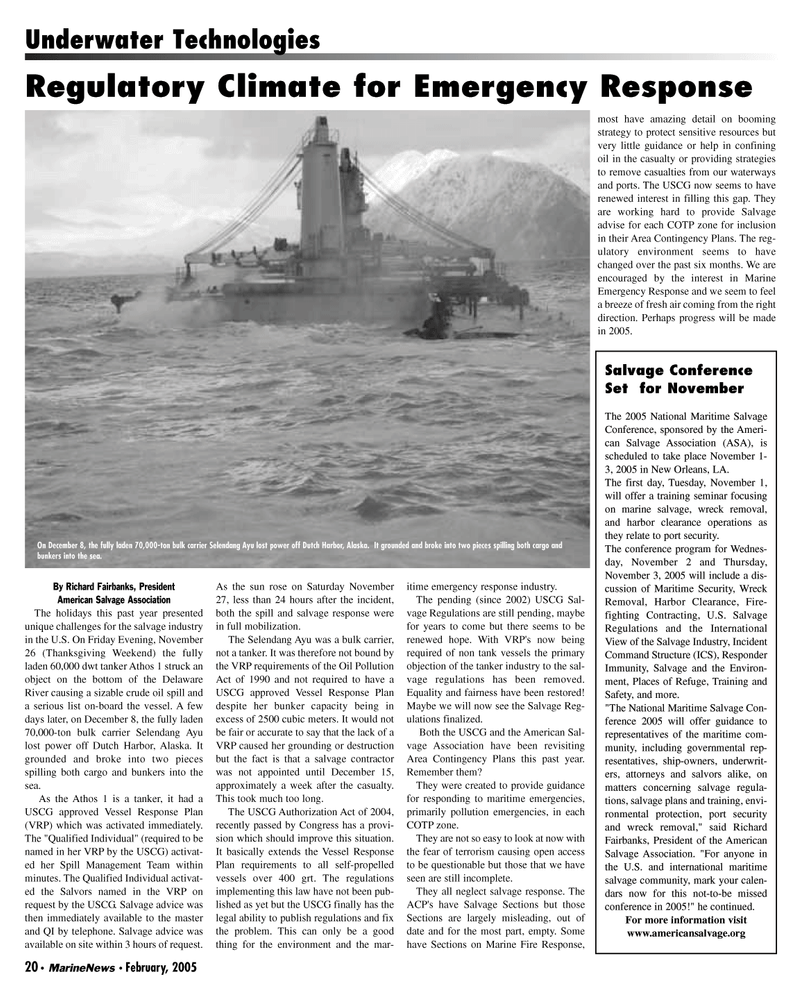
Page 20: of Marine News Magazine (February 2005)
Read this page in Pdf, Flash or Html5 edition of February 2005 Marine News Magazine
By Richard Fairbanks, President
American Salvage Association
The holidays this past year presented unique challenges for the salvage industry in the U.S. On Friday Evening, November 26 (Thanksgiving Weekend) the fully laden 60,000 dwt tanker Athos 1 struck an object on the bottom of the Delaware
River causing a sizable crude oil spill and a serious list on-board the vessel. A few days later, on December 8, the fully laden 70,000-ton bulk carrier Selendang Ayu lost power off Dutch Harbor, Alaska. It grounded and broke into two pieces spilling both cargo and bunkers into the sea.
As the Athos 1 is a tanker, it had a
USCG approved Vessel Response Plan (VRP) which was activated immediately.
The "Qualified Individual" (required to be named in her VRP by the USCG) activat- ed her Spill Management Team within minutes. The Qualified Individual activat- ed the Salvors named in the VRP on request by the USCG. Salvage advice was then immediately available to the master and QI by telephone. Salvage advice was available on site within 3 hours of request.
As the sun rose on Saturday November 27, less than 24 hours after the incident, both the spill and salvage response were in full mobilization.
The Selendang Ayu was a bulk carrier, not a tanker. It was therefore not bound by the VRP requirements of the Oil Pollution
Act of 1990 and not required to have a
USCG approved Vessel Response Plan despite her bunker capacity being in excess of 2500 cubic meters. It would not be fair or accurate to say that the lack of a
VRP caused her grounding or destruction but the fact is that a salvage contractor was not appointed until December 15, approximately a week after the casualty.
This took much too long.
The USCG Authorization Act of 2004, recently passed by Congress has a provi- sion which should improve this situation.
It basically extends the Vessel Response
Plan requirements to all self-propelled vessels over 400 grt. The regulations implementing this law have not been pub- lished as yet but the USCG finally has the legal ability to publish regulations and fix the problem. This can only be a good thing for the environment and the mar- itime emergency response industry.
The pending (since 2002) USCG Sal- vage Regulations are still pending, maybe for years to come but there seems to be renewed hope. With VRP's now being required of non tank vessels the primary objection of the tanker industry to the sal- vage regulations has been removed.
Equality and fairness have been restored!
Maybe we will now see the Salvage Reg- ulations finalized.
Both the USCG and the American Sal- vage Association have been revisiting
Area Contingency Plans this past year.
Remember them?
They were created to provide guidance for responding to maritime emergencies, primarily pollution emergencies, in each
COTP zone.
They are not so easy to look at now with the fear of terrorism causing open access to be questionable but those that we have seen are still incomplete.
They all neglect salvage response. The
ACP's have Salvage Sections but those
Sections are largely misleading, out of date and for the most part, empty. Some have Sections on Marine Fire Response, most have amazing detail on booming strategy to protect sensitive resources but very little guidance or help in confining oil in the casualty or providing strategies to remove casualties from our waterways and ports. The USCG now seems to have renewed interest in filling this gap. They are working hard to provide Salvage advise for each COTP zone for inclusion in their Area Contingency Plans. The reg- ulatory environment seems to have changed over the past six months. We are encouraged by the interest in Marine
Emergency Response and we seem to feel a breeze of fresh air coming from the right direction. Perhaps progress will be made in 2005. 20 • MarineNews • February, 2005
Underwater Technologies
Regulatory Climate for Emergency Response
Salvage Conference
Set for November
The 2005 National Maritime Salvage
Conference, sponsored by the Ameri- can Salvage Association (ASA), is scheduled to take place November 1- 3, 2005 in New Orleans, LA.
The first day, Tuesday, November 1, will offer a training seminar focusing on marine salvage, wreck removal, and harbor clearance operations as they relate to port security.
The conference program for Wednes- day, November 2 and Thursday,
November 3, 2005 will include a dis- cussion of Maritime Security, Wreck
Removal, Harbor Clearance, Fire- fighting Contracting, U.S. Salvage
Regulations and the International
View of the Salvage Industry, Incident
Command Structure (ICS), Responder
Immunity, Salvage and the Environ- ment, Places of Refuge, Training and
Safety, and more. "The National Maritime Salvage Con- ference 2005 will offer guidance to representatives of the maritime com- munity, including governmental rep- resentatives, ship-owners, underwrit- ers, attorneys and salvors alike, on matters concerning salvage regula- tions, salvage plans and training, envi- ronmental protection, port security and wreck removal," said Richard
Fairbanks, President of the American
Salvage Association. "For anyone in the U.S. and international maritime salvage community, mark your calen- dars now for this not-to-be missed conference in 2005!" he continued.
For more information visit www.americansalvage.org
On December 8, the fully laden 70,000-ton bulk carrier Selendang Ayu lost power off Dutch Harbor, Alaska. It grounded and broke into two pieces spilling both cargo and bunkers into the sea.
MN FEB05 (17-24).qxd 1/26/2005 4:32 PM Page 20

 19
19

 21
21
